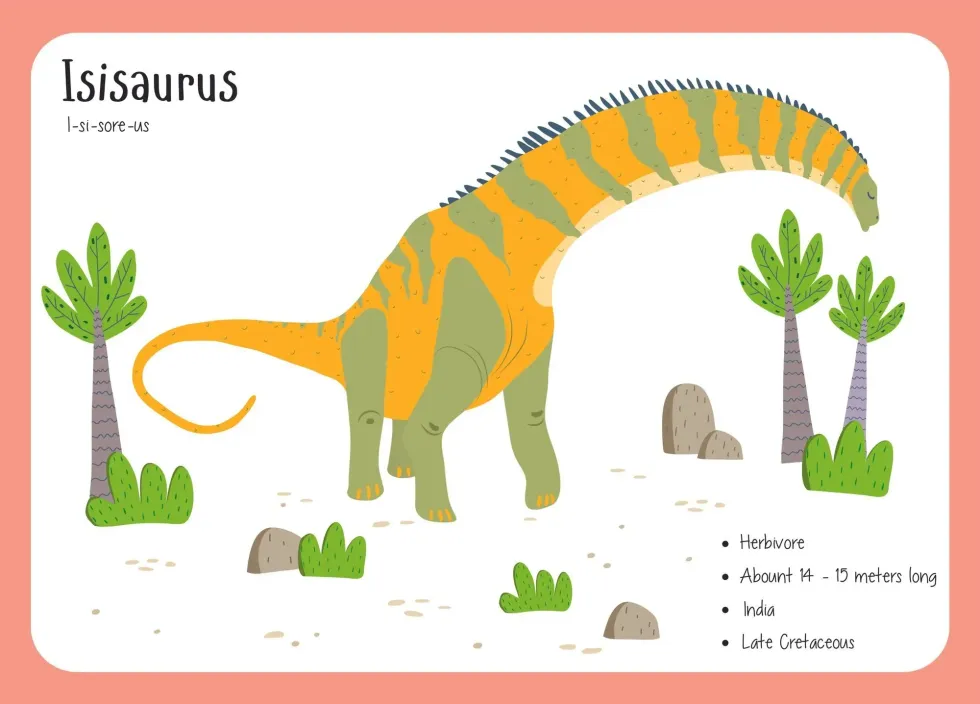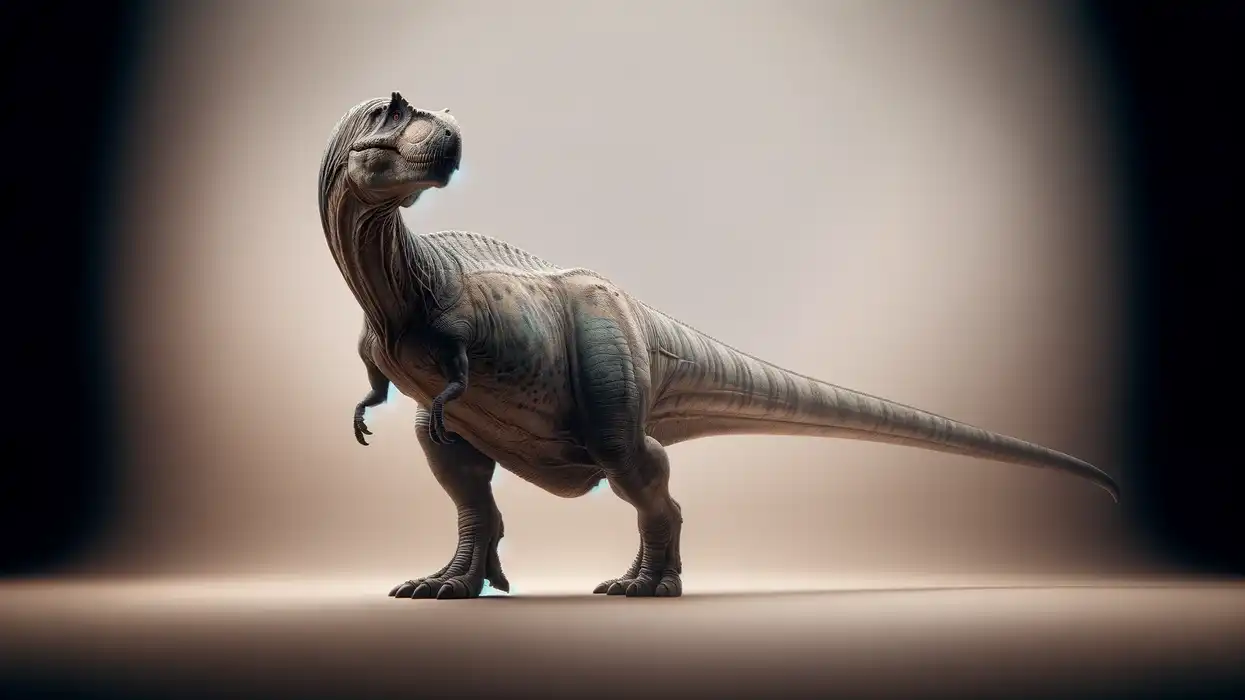Most of the specimens of Isisaurus and its history were uncovered by Saswati Bandyopadhya and Sohan Jain between 1984 and 1986, who also originally gave them the name Titanosaurus Colberti. Based on its partial skeleton, it has been known to be moderate in size with long forelimbs.
The Isisaurus time span dates back to the late Cretaceous time and was believed to have inhabited the regions of India. Based on research estimates, the Isisaurus size is 59.1 ft (18 m) in length.
The Isisaurus height or Isisaurus dimensions are not yet known. The fossils that were uncovered by Jain and Bandpadhya included postcranial remains along with other bones. However, the skull has not yet been discovered.
They were identified to be herbivores, feeding on different plant species. It is believed, the Isisaurus would have coexisted with Jainosaurus along with other predatory species, in the lands of India.
Isisaurus meaning Indian Statistical Institute had long forelimbs, but a relatively shorter length neck, if compared to other Sauropods. They largely inhabited terrestrial habitats like grasslands, forests, and wetlands.
If you are fascinated by the Isisaurus, then you may want to continue reading our other amazing facts about them. If you want to learn more about different dinosaurs around the world, check out these Chungkingosaurus facts and Bradycneme facts.
Isisaurus Interesting Facts
How do you pronounce 'Isisaurus'?
Isisaurus is pronounced as I-si-sore-us.
What type of dinosaur was an Isisaurus?
Isisaurus is described as a Titanosaurus, which is a genus of sauropod dinosaurs. Most of the specimens of Isisaurus (meaning Indian Statistical Institute) were uncovered by Saswati Bandyopadhya and Sohan Jain , who also gave them the name Titanosaurus Colberti.
However much later in 2003, Wilson and Upchurch placed them under a new genus classification and their new name was Isisaurus Colberti. They inhabited the regions of present-day India and dated back to the late Cretaceous time.
In which geological period did the Isisaurus roam the earth?
This species of dinosaur is believed to have walked this earth during the late Cretaceous period, based on the history or fossils discovered by Jain and Saswati Bandyopadhya.
When did the Isisaurus become extinct?
The exact period when this genus of Sauropoda dinosaurs became extinct is not yet studied. However, dinosaurs, in general, have been studied to become extinct almost 65 million years ago.
Where did an Isisaurus live?
Isisaurus inhabited the middle and western parts of present-day India, as well as in the western parts of Pakistan.
What was an Isisaurus' habitat?
This dinosaur of the Late Cretaceous time has been known to inhabit terrestrial habitats like forests, grasslands, and wetlands.
Who did an Isisaurus live with?
Isisaurus meaning Indian Statistical Institute belonged to the Late Cretaceous time. It is estimated, Isisaurus would have co-existed with another similar genus of Titanosaurus, known as Jainosaurus.
How long did an Isisaurus live?
The exact lifespan of this giant lizard from India is not yet studied. However, dinosaurs, in general, had an average lifespan of 30-80 years. So Isisaurus age can be somewhat similar.
How did they reproduce?
All species of dinosaurs largely reproduced by laying eggs. After the hatching of the eggs, new juveniles were born. Not much is known about their specific reproductive patterns.
Isisaurus Fun Facts
What did an Isisaurus look like?
The Isisaurus dinosaur (initially called Titanosaurus colberti) had similar physical characteristics to a modern-day giraffe. It had long forelimbs and the Isisaurus neck was short in size. Based on the fossil remains discovered, an adult of this species was 59.1 ft (18 m) in length.
How many bones did an Isisaurus have?
The exact number of bones that this dinosaur had, is not yet known, since not all parts of the Isisaurus skeleton were found. The fossil remains that were discovered were mostly postcranial and included the ribs, pelvis, and other bones.
The skull of this dinosaur is yet to be discovered. Jain and Saswati Bandyopadhya uncovered most of the fossil remains between 1984 and 1986 and named them Titanosaurus colberti. They were placed under a new genus type by Wilson and Upchurch in 2003 and named them Isisaurus Colberti.
How did they communicate?
The exact communication process followed by this dinosaur that walked on the lands of India is not yet studied. However, dinosaurs generally used both vocal and visual communications.
According to research, it is estimated, they might have used hot, or cracking sounds, to send signals to each other. Many a time, they also produced several love calls, especially during courtship.
How big was an Isisaurus?
On the basis of different fossil remains found of this animal, the size of Isisaurus is described to be 59.1 ft (18 m) in length. They were taller than a puertasaurus.
How fast could an Isisaurus move?
Not much is known about the speed of this Sauropoda (initially named Titanosaurus colberti) from India. Since they were herbivores, it can be safely assumed that they could not run as fast as other predatory species.
The forelimbs of this dinosaur from India were quite long in size, however, the hindlimbs have not yet been discovered, and therefore, no clear estimate can be made.
How much did an Isisaurus weigh?
The size of this species is estimated to be 30864.7 lb (14,000 kg).
What were the male and female names of the species?
There is no sex-specific name for this Sauropoda species which was initially named Titanosaurus colberti. A male was simply called a male Isisaurus and a female was known as a female Isisaurus.
What would you call a baby Isisaurus?
A baby Isisaurus was known as a juvenile.
What did they eat?
According to several research estimates, this new titanosaurid (initially named Titanosaurus colberti), of the Late Cretaceous time was described to be a herbivore. The Isisaurus diet largely consisted of different types of trees.
How aggressive were they?
There is no confirmed theory about the behavior of this Sauropoda. However since they were herbivores, it can be safely assumed they were rather non-aggressive by nature, compared to other predatory animals.
Did you know...
This Sauropoda is known to be a herbivore based on the fungus which has been discovered in their coprolites (fossiled dung). The fungus was identified to be pathogens that were commonly seen in tree leaves.
Why did they have long necks?
The Isisaurus necks were relatively shorter in size than other Sauropodas, which made them quite different. There is no confirmed theory as to why they had such long necks.
However, since they were herbivores by nature, it can be assumed that the long necks helped them reach the leaves of tall trees. Isisauru has a similar physical appearance to that of a modern-day giraffe.
How did the Isisaurus get its name?
This species, which dated back to the late Cretaceous period get its name from the Indian Statistical Institute. Most of the fossils of the dinosaur were discovered by Sohan Lal Jain and Saswati Bandyopadhya between 1984 and 1986.
Both Jain and Bandyopadhya originally named this species Titanosaurus Colberti in 1997. However, much later in 2003, Wilson and Upchurch placed them under a new genus classification of their own and named them Isisaurus Colberti after the Indian Statistical Institute.
Only a partial skeleton was discovered which was mostly postcranial. The skull is yet to be discovered.
Here at Kidadl, we have carefully created lots of interesting family-friendly dinosaur facts for everyone to discover! For more relatable content, check out these Nothosaurus interesting facts, or Clidastes facts for kids.
You can even occupy yourself at home by coloring in one of our free printable volcano and dinosaurs coloring pages.
Second image by DiBgd at English Wikipedia








